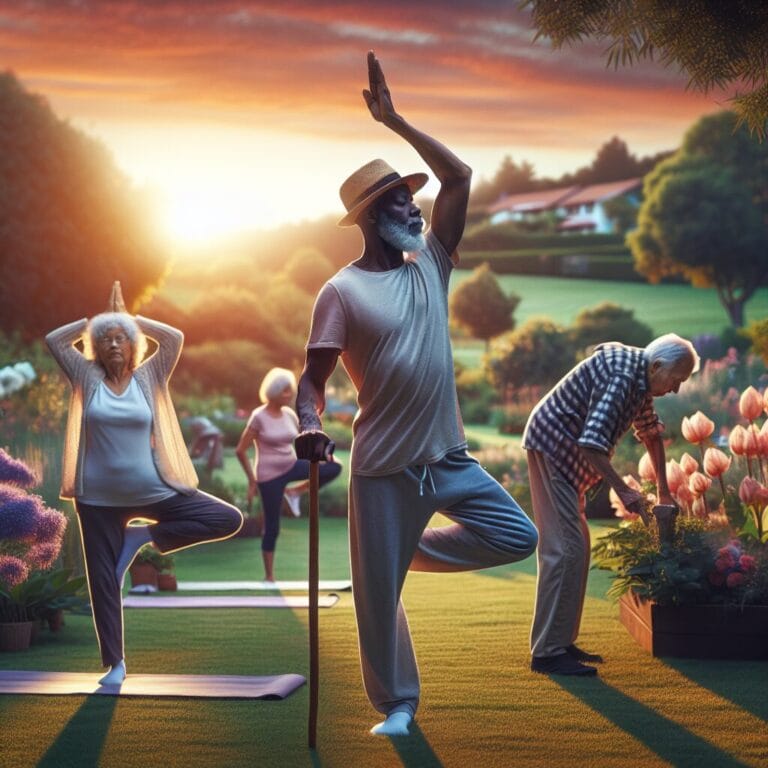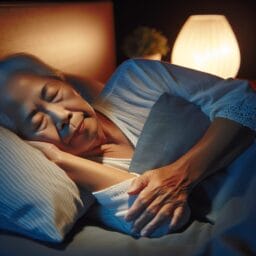
Enhancing Rest: Sleep Optimization Tips for Older Adults Who Exercise Regularly
Table of Contents
- Introduction
- Understanding Sleep Patterns in Older Adults
- Pre-Sleep Exercise Considerations
- Creating a Sleep-Optimizing Environment
- Nutritional Guidelines for Enhanced Rest
- Relaxation Techniques for Improved Sleep Quality
- Sleep Aids and Supplements
- Adapting to Changing Sleep Needs
- Conclusion
- Frequently Asked Questions
Introduction
Did you know that not all zzz’s are created equal, especially as we age? For older adults, catching those elusive quality winks can be a bit like trying to thread a needle in the dark. But here’s an eye-opener—regular physical activity is like a Swiss Army knife for snooze issues! It’s true, staying active isn’t just about keeping muscles spry; it can also bring on the sandman more effectively.
Now, picture this: it’s late at night and your mind’s racing faster than grandkids on sugar—time for some good old fashioned exercise magic! By engaging in suitable physical activity programs earlier in the day, community-dwelling older adults might find themselves not only initiating sleep quicker but also maintaining that sweet slumber longer. Exercise ramps up the homeostatic sleep drive—the body’s need for sleep based on how long we’ve been awake. This means after a day filled with activities, climbing into bed feels oh-so-right.
Plus, imagine weaving natural remedies into your nightly routine. Herbs like valerian, chamomile, and passionflower have been whispered through the ages to help unwind those tight springs of insomnia symptoms. They’re Mother Nature’s lullabies with fewer adverse effects than over-the-counter medications or prescription drugs—which is good news since older patients often need to sidestep anything that risks cognitive impairment.
The connection between mental health and shut-eye cannot be understated either. Significant improvements in mood may just be a few pillow flips away when exercise and sleep disturbances dance to the same beat. Studies note modest improvement in both subjective measures—how folks report their rest—and objective measures—what science says—is significant enough to make exercise programs worth considering.
So there you have it: lace-up those sneakers by day for better dreams by night! Older adults who put this dynamic duo to work could see significantly improved sleep outcomes without counting sheep till dawn. And that’s something to smile about even before hitting the hay!
Understanding Sleep Patterns in Older Adults
Picture this scene: a cozy bedroom, moonlight spilling through the curtains, and an older adult nestling into bed after a day filled with gentle yoga and a twilight stroll. What’s not often discussed is how sleep architecture—the structure of different stages of sleep—changes as we age. Did you know that deep sleep, the kind that really recharges our batteries, tends to play hide and seek with older adults? But here’s the good news: physical activity could be just the secret ingredient to coaxing back that restorative slumber!
Regular exercise can act like a symphony conductor for our internal clocks, fine-tuning our circadian rhythms so that drifting off becomes less of a nighttime wrestling match. Studies have found that community-dwelling older adults participating in consistent exercise programs experience significant effects on their sleep quality—not only falling asleep faster but also maintaining sleep longer.
For those facing the night-time nemesis known as insomnia—where initiating sleep feels like an uphill battle—regular physical activity emerges as a non-drug treatment with high success rates. These activities don’t need to be marathon runs; even light exercises like tai chi have been shown to lead to modest improvements in both subjective measures (how refreshed someone feels) and objective measures (what scientific gadgets confirm about sleep quality).
Other common gremlins under the bed include sleep disorders such as obstructive sleep apnea or restless legs syndrome. While physical activity might not banish these baddies on its own, it’s part of the gold-standard treatment alongside other interventions. By increasing aerobic health and muscle tone and reducing stress before bedtime, exercise helps fortify the body’s defenses against these nocturnal disruptions.
But wait! Before you jump into your pajamas ready for dreamland post-exercise, remember moderation is key. Overexertion might lead to increased risk of over-stimulating your system rather than winding down. Older patients should aim for moderate-intensity activities regularly interspersed throughout their week—for optimal snooze control.
So there you have it—a toolkit brimming with secrets for improving sleep outcomes in older adults. From battling chronic insomnia to enhancing mental functioning after sundown, sticking to a well-rounded physical activity program could be your ticket to dreamland. Say goodbye to sheep counting and embrace sweet dreams powered by movement!
Pre-Sleep Exercise Considerations
Rolling out of bed after a restless night can feel like starting your day with a flat tire—annoying and hard to get moving, right? Well, older adults feeling sleep-deprived might just need to tweak their daily routines. Timing is everything, and it seems that when older folks do their leg stretches and arm curls can make all the difference for top-notch zzz’s later on.
Imagine this: It’s early evening; instead of settling in front of the TV, popping in a gentle workout DVD could be the golden ticket to dreamland. That’s because physical activity—especially if done several hours before bedtime—warms up the body just enough so that by nighttime, it starts cooling down, signaling sleep time to your brain. Think of it like warming up leftovers—it takes a little bit before they’re ready to enjoy!
Now let’s talk types of workouts—we’re not prepping for the Olympics here! Simple stuff like walking, swimming or even gardening can get the job done. These are like the comfort food of exercise for our seasoned squad: satisfying but not too spicy. And here’s a fun twist: mixing things up keeps both mind and muscles guessing, which might just lead to better snooze outcomes.
As for how hard to go at it, think “Goldilocks” intensity—not too hot, not too cold—but just right. Breaking a light sweat beats pushing so hard that catching breaths becomes tougher than solving a jigsaw puzzle blindfolded. Studies suggest moderate-intensity aerobic activities hit the sweet spot for improving sleep quality without overdoing it.
So there you have it: whether you’re swimming laps or planting petunias, keep an eye on the clock and find that perfect tempo. Do these things and those significantly improved sleep patterns might start feeling less like fairy tales and more like your every night reality!

Creating a Sleep-Optimizing Environment
Set the stage for a serene slumber by transforming your bedroom into a sanctuary of sleep—it’s like building a nest that’s just right for dozing off! Banish the blaring TV and swap out those buzzing gadgets an hour before bed, as they’re gatecrashers to your dream party. Instead, cozy up with a book (the kind with actual pages) or some soothing tunes that whisper “relax” to every part of you.
Dive under the covers in room that’s not too hot, not too cold, but feels like you’ve stepped into a gentle spring morning—experts suggest around 65 degrees is the magic number. It’s important because your body temp drops when it’s time to catch some Z’s, so keeping things cool helps kick-start that shut-eye process.
Imagine flipping a switch and having all your worries fade away—that’s what soft, warm lighting does before bedtime. Use dimmer switches or lamps with low-watt bulbs to tell your brain the stars are coming out and it’s time to wind down.
Noise can be a sneaky sleep snatcher for older adults! Whether it’s street sounds or a ticking clock, it can tug at the edges of your dreams. But don’t fret; white noise machines work like charm, lulling you with rhythms that drown out pesky pitter-patters.
And here’s something neat: did you know plants can be silent sleep champions? Besides adding a splash of greenery to your space, they gobble up stress and breathe out peaceful vibes throughout the room. Place one by your bedside for a natural touch that also cleanses the air!
Lastly, let’s not forget about our fluffy pillow pals and mattress buddies – picking ones that hug your body just right can make all the difference between counting stars versus sheep. So fluff up those pillows and invest in a supportive mattress; think of them as trusty sidekicks on your nightly quest for quality snooze.
| Aspect | Recommendation | Reason |
|---|---|---|
| Electronic Devices | Remove or turn off an hour before bed | Reduces stimulation from screens and gadgets |
| Room Temperature | Around 65 degrees Fahrenheit | Supports natural drop in body temperature for sleep |
| Lighting | Soft, warm lighting with dimmers or low-watt bulbs | Signals to the brain it’s time to wind down |
| Noise | Use white noise machines | Drowns out disruptive sounds for a peaceful sleep |
| Plants | Add plants to the bedroom | Improves air quality and adds a calming presence |
| Bedding | Choose comfortable pillows and a supportive mattress | Enhances comfort and supports the body |
Nutritional Guidelines for Enhanced Rest
Did you know that the snacks and meals older adults choose can turn a night of tossing and turning into a slumber celebration? Yep, it’s not just about counting sheep; what’s on your plate counts too! Now, let’s dish out some sleepy-time food wisdom. Chowing down on cherries can be a game-changer—they’re like nature’s sleeping pills, packed with melatonin to help keep sleep patterns in check.
And hey, if sipping warm milk reminds you of grandma’s house, there’s science behind those cozy feels. Dairy has tryptophan which nudges the brain into sleepy mode—so go ahead and embrace a nightcap of milk or yogurt. Pairing this with complex carbs like oatmeal or whole-grain toast can also invite Mr. Sandman to visit.
Meal timing? It’s big for bedtime success! Gobbling grub too close to lights out means your body is busy digesting when it should be dreaming. Aim to have dinner earlier in the evening—and if hunger pangs hit late at night, opt for a light snack over a feast.
Now let’s splash into hydration—the unsung hero of zzz’s. Staying well-watered ensures everything in the body flows smoothly but balancing this with fewer evening sips minimizes midnight marches to the bathroom. Herbal teas are fantastic hydrators that carry added snooze-boosting benefits—think chamomile or peppermint as calming cuppas before bed.
So there we have it: sip smartly, plate up sleep-friendly treats, time your last bite right, and watch how these tweaks whisk away those sleep complaints quicker than you can say “goodnight!” With such culinary strategies up your pajama sleeves, significantly improved rest awaits!
Relaxation Techniques for Improved Sleep Quality
When it comes to catching some quality Zzz’s, older adults could find a new friend in mindfulness and meditation—like secret agents working undercover to quiet the mind and prep the body for a first-class ticket to dreamland. These practices are not just sitting quietly; they’re active training for your brain, turning down the volume of racing thoughts that often lead to sleep complaints and disrupting those precious cycles of shut-eye. Adding a sprinkle of mindfulness into your evening routine can be as easy as taking deep breaths or practicing gratitude—it’s like giving your mind a cozy blanket to snuggle with!
Breathing exercises are especially nifty. They work behind the scenes, sending signals that it’s time for your body to switch from go-go-go mode into slow-slow-slow gear. Picture this: you’re breathing in calm, breathing out stress, watching worries float away like bubbles—poof! This isn’t hocus-pocus; it’s science at its best, folks. Deep and deliberate inhales followed by long exhales can boost oxygen flow and flip on the relaxation response in the body, helping maintain sleep through the night.
Then there’s progressive muscle relaxation (PMR), an all-star technique that coaches each part of you to release any tension hiding out. It goes something like this: tighten up those toes as if squishing sand at the beach, hold for a moment then whoosh—let them go floppy like spaghetti noodles! Work up from feet to forehead, tensing and relaxing each muscle group one by one. PMR is so good at improving sleep outcomes that before you know it, you’ll be floating on cloud nine instead of counting those stubborn sheep.
Add these strategies into your nightly playbook, mix them with regular physical activity programs during daylight hours, steer clear of caffeine late in the day (that jittery culprit!), and older patients might just see significant improvements without any adverse effects from over-the-counter medications or prescription drugs—and that means keeping cognitive impairment at bay too! So why not try turning bedtime into a serene scene filled with deep breaths and peaceful stretches? The result could be significantly improved slumber scores across the board!
Sleep Aids and Supplements
Wake up to the wonders of natural supplements – they might just be the sleep heroes for older adults looking to catch some dreamy Zzz’s without any fuss. Picture this: a sprinkle of magnesium here, a dash of melatonin there, and presto – these gentle helpers can nudge your body toward night-night land. Magnesium is a bit like a cozy bedtime story for your muscles, whispering them into relaxation mode, while melatonin acts like the sandman’s sidekick, guiding your internal clock to slumberland.
Yet, tread lightly with these sleep soldiers! Over-the-counter doesn’t mean overboard; it’s super important to chat with healthcare hotshots before starting any new supplement jamboree. These experts are like guardians of good rest, ensuring older patients steer clear from any sneaky side-effects that might disrupt their snooze cruise or cause cognitive fog.
When sheep counting turns into sheep herding and you’re still wide awake, waving a white flag at insomnia symptoms might seem tempting but hit pause on that thought. Here’s when you holler for help from the sleep savvy professionals. If those restless nights are piling up faster than pancakes on Sunday morning, getting advice from sleep doctors is key—they know all about turning bumpy nights into smooth sailing.
So remember friends, dive into the pool of physical activity programs by day and consider natural sleep aids as part of your nighttime routine carefully. With this dynamic duo in play—exercise during sunlight hours and safe supplementation come twilight—you’re setting yourself up for significantly improved winks galore! Just make sure to seek guidance from those in-the-know if unsure about trying out any new bedtime brews or pills. Your golden years should be filled with dreams so sweet that every morning feels like waking up on cloud nine!
Adapting to Changing Sleep Needs
Imagine this: a secret sleep club where older adults are VIP members, and the currency is savvy sleep strategies. Yes, that’s right! As we age, our bodies’ natural sleep rhythms can get a bit out of funk, like an old clock that needs winding. But fear not, because recognizing new sleep patterns is the first step to becoming a snooze connoisseur.
Now let’s unleash some lesser-known intel on combating those pesky sleep disturbances! Did you know your bedtime environment could be as influential as a five-star hotel room for inducing shut-eye? We’re talking about setting up your very own haven of relaxation—think cozy blankets infused with calming scents like lavender or vanilla. These subtle changes signal the brain it’s time to power down, gently escorting you into dreamland.
But what if your best efforts to create Sleepville in your bedroom still leave you staring at the ceiling? That’s when it’s time to call in the cavalry—sleep professionals who can offer personalized strategies beyond counting woolly companions. They’ll help craft a battle plan against any tenacious insomnia symptoms using their arsenal of knowledge about physical activity programs, dietary choices, and cognitive-behavioral techniques.
Remember how our grandparents swore by ‘a stitch in time saves nine’? Well, applying that logic to sleep means addressing even minor nighttime niggles before they bloom into full-blown chronic insomnia. Trusty experts can guide older patients through this maze with advice tailored just for them, ensuring gold-standard treatments are in place without going overboard on those tempting over-the-counter medications or prescription drugs that might come with unwanted baggage like adverse effects.
So whether you’re part of the gray-haired brigade facing difficulties falling back asleep or simply a generally healthy older adult seeking significant effects from gentle exercise routines before bedtimes—join forces with healthcare heroes and discover significantly improved slumber successes! Say “nighty-night” to nighttime woes and embrace mornings feeling refreshed as though every night’s rest was woven from sweetest dreams by fairies themselves. After all, every senior deserves to drift off effortlessly into their own personal starry nights.
Conclusion
Did you ever think of sleep as your very own time machine to youthfulness? For our seasoned pals out there, a snooze strategy might just be the ticket to turning back the hands of time. Let’s zip open another secret from the sleep optimization vault – something not chatted about yet! You see, while regular strolls and tai chi can do wonders for those nighttime escapades into dreamland, adding some pizzazz to your morning routine might also help keep the sandman on speed dial.
Imagine greeting the sun with a few joyful stretches or grooving to some golden oldies. This kick-starts your day with an energy boost that makes you shine brighter than a new penny! By keeping active when the rooster crows, older adults set their internal clocks ticking just right, leading to improved sleep quality when stars twinkle in the sky. Plus, this could sharpen mental functioning more than a roomful of crossword puzzles!
Now let’s sprinkle in some extra magic – mindfulness during these activities can heighten their impact. Whether it’s breathing in fresh air or noticing each petal on a blooming daisy during your garden patrol, being present increases relaxation which helps later when it’s time to tuck into bed. So there you have it – throw in some zestful mornings with your exercise programs and watch as bedtime becomes a welcome friend rather than a pesky fly buzzing around.
And hey, don’t forget about those wondrous herbs valerian chamomile passionflower; they’re like Mother Nature’s sleepy dust without any frights of adverse effects lurking after dawn. No need for over-the-counter concoctions when you’ve got nature’s pantry at hand! So here’s to significantly improved slumber – sweet dreams await on the other side of active days filled with mindful moments and evening serenades of peace from natural aids!




